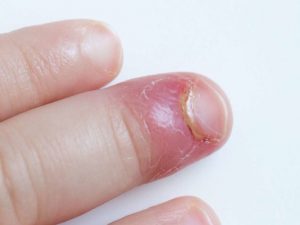NAIL INFECTION (PARONYCHIA)
Paronychia is an infection of the skin around the finger or toenails. It develops around the edges of the nail at the bottom or sides. It can affect more than one fingernails or toenails at a time.
There are two types of paronychia- acute and chronic.
The acute paronychia develops over hours to days. The infection is usually superficial (not deep into the skin). Prompt treatment can reduce symptoms quickly. Acute paronychia is usually caused by bacteria. See the image below:

Acute paronychia
Image credit: Medical News Today
The chronic paronychia persists over a period of 6 weeks at least. It is more serious and affect several digits at once. It most time caused by fungi. See the image below:

SIGN AND SYMPTOMS OF PARONYCHIA
- Redness, swelling and pain around the nail.
- Warmth around the nail
- Separation of nail from the nail bed.
- Deformation or damage of the nail
- Hardening of the nail.
RISK FACTORS THAT MAY PREDISPOSE INDIVIDUAL TO HAVING PARONYCHIA
- Diabetes mellitus
- Use of antiviral drug like lamivudine and indinavir
- Obesity Read this here: CORO-WEIGHT!
- Poor immune system
- HIV/AIDS Read this here: The World AIDS Day, December 1
- Hyperhydrosis Read this here: TALKING ABOUT EXCESSIVE SWEATING BY DR. ADEYEMO OLUSOLA
- Nail sucking
- Nail biting
- Sculpted nail
- Frequent hand immersion in water
- Nail trauma or injury
- Clipping the nail too short
- Manicure
TREATMENT
The treatment option adopted depends on identifying whether the infection is acute or chronic.
An individual with acute paronychia can soak the affected finger or toe in warm water three to four times a day. If symptoms do not improve, further treatments should be sought with your doctor.
When bacterial infection causes acute paronychia, a doctor may recommend an antibiotic while in a case of chronic paronychia which if usually caused by fungi, topical antifungal drug is applied.
Chronic paronychia may require weeks or months of treatment. It is important to keep the hands dry and clean throughout. If a person’s job requires their hands to be wet or exposed to germs, they may need to take time off.
Your doctor may also need to drain any pus from the surrounding abscesses. To do this, he will provide local anesthetic, then open the nail fold enough to insert gauze, which will help drain the pus.
REFERENCES:
Medscape
Medical News Today
FURTHER READING:
TALKING ABOUT EXCESSIVE SWEATING BY DR. ADEYEMO OLUSOLA
The World AIDS Day, December 1

